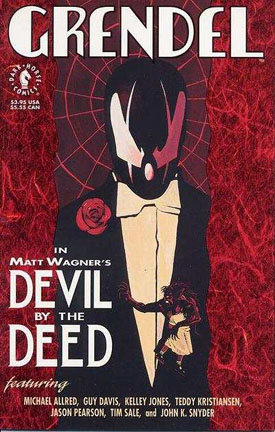 Matt Wagner’s Grendel, as I’ve mentioned before, was in many ways revolutionary. In spite of the initial, mostly negative, reaction, it proved to be one of the milestones in the development of comics as a form. Some of the thematic and character elements have become standard, and while I’m not going to stick my neck out and say that Wagner was the first, he was certainly at the leading edge of what became the mainstream.
Matt Wagner’s Grendel, as I’ve mentioned before, was in many ways revolutionary. In spite of the initial, mostly negative, reaction, it proved to be one of the milestones in the development of comics as a form. Some of the thematic and character elements have become standard, and while I’m not going to stick my neck out and say that Wagner was the first, he was certainly at the leading edge of what became the mainstream.
Grendel: Devil by the Deed represents another breakthrough. It is, in general terms, the story of Grendel’s first incarnation, Hunter Rose, as told from his journals by his granddaughter, Christine Spar. It gives, in summary form, the full if somewhat elliptical story of the rise of the mutant genius Grendel and his ongoing struggle with the wolf-shaman Argent, including their climactic battle. Also featured is the role played by Rose’s adopted daughter, Stacy Palumbo, in his ultimate downfall.
What is unique about this one, which began as a backup to Wagner’s previous serial, Mage, is the formal treatment. It may seem odd to talk about formal elements in relation to comics, but bear with me: comics as a genre is as much a formal idiom as any other medium, even if we don’t always recognize it. (I once read a fascinating bit about the formal structure of popular songs – and yes, there is one, and if you listen you can hear it. It runs roughly, if I can trust my memory: verse, chorus, probably another verse/chorus, and again if the songwriter has anything on the ball, instrumental break, verse/chorus (which is really a sort of resolution), reprise, and maybe a coda. All within two to four minutes, as a rule. Interestingly enough, stretching that time frame usually involves an extended break and/or coda.)
So, what about the formal elements of comics? As far as Devil by the Deed is concerned, as Alan Moore points out in his introduction, Wagner has created a bridge between the standard comics structure of narrative carried by illustrations in frames and dialogue in word balloons, and the illustrated novel, in which occasional pictures give visual representation to incidents in the text. In Wagner’s hands, the illustrations become the frames and the narrative is rendered in captions that occupy their own frames. The narrative flow becomes much less linear, the illustrations take on much more of the narrative burden than they do in a novel, although not quite as much as they do in comics, the text becomes much more of a visual element, and the possibilities for ambiguity are greatly enlarged. (I mention this last because, looking through this example, I note that the reader is often faced with choices balanced between the normal reading habit and the demands of the layout.)
Graphically, this is stunning. For starters, Wagner has adopted a fairly cavalier attitude toward the standard frame arrangement, which is a characteristic of what I’ve seen of modern graphic novels – fluidity has become a formal element that works against the traditional arrangement of boxes across and down a page. In Wagner’s hands, this translates into page layouts that owe nothing to the way we habitually read and everything to the control a graphic designer can exert, leading us to read the way he wants us to read. There are several pages here that, simply in terms of pure design, are breathtaking. Add in the Grendel color scheme of black, white and red, and you have an arresting visual treat.
My one cavil is the size of the type in the captions. I am reassured that my difficulties with this are not a sign of advancing age or diminution of my faculties: a much younger colleague – a visual artist, as it happens — looked at the book and said, “You can read this? From that far away?” I rest my case.
When it comes right down to it, Dark Horse’s reissue of this segment of Wagner’s work is more than welcome: Devil by the Deed is an essential part of the Grendel story, and to have it in a nice sturdy hardbound edition with a new introduction by Wagner is a plus.
(Dark Horse Comics, 2007 [orig. Comico, 1986])
